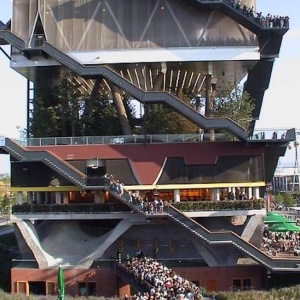Dutch Pavilion in Hannover Expo 2000 World’s Fair
Environmental architecture or modern Prometheus’ nightmare
DOI:
https://doi.org/10.35305/23626097v4i6.33Keywords:
architecture, criticism, Holland, space, symbolic capitalAbstract
Hannover Expo 2000 World’s Fair was held under the motto: Man, Nature and Technology – Origin of a New World. Almost twenty years afterwards, the Dutch Pavilion remains as the most representative image of not only the disciplinary field but also mass culture. Under the motto Holland creates space, MvRdV sought to devise a self-sustaining unit grounded on the water-cycle artificial recreation. The aim was to show the plausibility of the co-existence of both population density and quality life increase. Global culture times –which are characterized by the ceaseless flow of mass consumption images- have led to the discussion of architecture’s own role as never before because of the conditions affecting its grounds. They have also given raise to a gap between the completed object and the individual’s space experience as well as a conflict absence considered to be a cultural productive value. Criticism becomes crucial when facing the hegemonic discourse that indistinctively imposes behaviors. It should be necessary to focus on the key role played by the discipline in the development of symbolic capital which deals with environmental concerns as emerging contemporary issues.
Downloads
Metrics

Downloads
Published
How to Cite
Issue
Section
License
Open access policy
A&P Continuidad is a non-profit and open access publication. According to Mexico Declaration on Cultural Policies, the journal distribution is submitted to Creative Commons Attribution-Noncommercial-ShareAlike 4.0 International Public License (CC BY-NC-SA). “Neither the commercial use of the original work nor that of the possible derivative works are allowed. The distribution of derivative works should be submitted to the license regulating the original work. This license is not free.”
A&P Continuidad authorizes the partial or full reproduction of texts and graphs provided that the source is cited. Authors are exclusively responsible for the criteria expressed in the articles which do not necessarily reflect the opinion of the Editorial Committee or that of the Direction Board. The copyright of the published articles pertains to their authors or publishers.
Transfer of rights
The acceptance of an article to be published implies the author’s transfer of rights to the journal. Authors continue to have the right to use the material in future books or publications, approve or veto the republication of their works as well as the rights related to patents or other rights. Transfer of rights form may be downloaded here.























 This OJS site and its metadata are under a
This OJS site and its metadata are under a 

